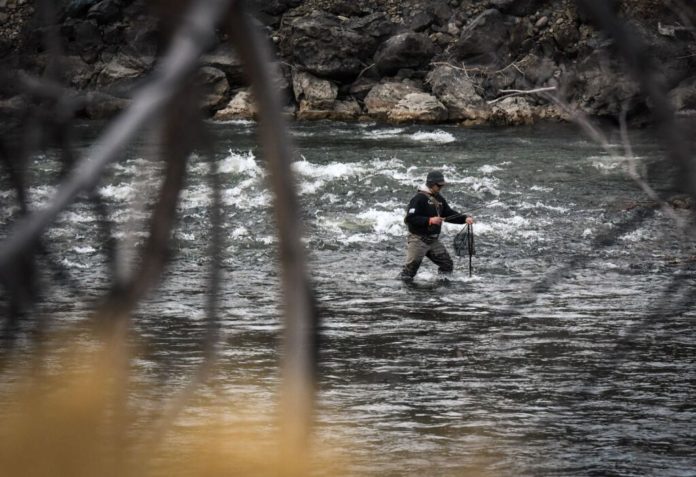Chelsea Self/Glenwood Springs Post Independent
A portion of the voluntary fishing closure on the Colorado River in Eagle County was lifted Tuesday as flows have improved over the last few days.
Colorado Parks and Wildlife, on Wednesday, placed a full-day voluntary fishing closure on the Colorado River beginning at the Colorado Highway 9 bridge in Kremmling downstream to the Colorado Highway 13 bridge in Rifle. On Tuesday, that closure was lifted upstream of State Bridge.
Downriver at the Catamount Bridge Boat Launch, nearby resident Jack Bombardier has been monitoring flows daily throughout the summer.
In the past, Bombardier has personally called in low-flow conditions with a plea to release more water from reservoirs upstream.
This year, however, after the gauge at Catamount reached a low of 5.5 feet Thursday to Friday, flows began to tick up and by Saturday, the gauge was up a couple of inches.
Bombardier, in an email, said the key to the rising flows has been the Shoshone water call, “and its very senior 1,200 (cubic feet per second) water right.”
“Since that water right is satisfied by the combined flows of the Eagle and the Colorado, as the Eagle’s level drops the Colorado goes up by a corresponding amount,” Bombardier said. “Most years that delicate dance gets unnoticed because there is plenty of water in both. Kind of a zero-sum game that works to the Colorado’s detriment, while reservoirs are filling. But going forward this summer, there should be good enough flows on the Colorado, while if fish are suffering due to warm water, it might be on the Eagle or Yampa.”
As of Tuesday, the gauge at Catamount was above 6 feet, up 6 inches in just a few days. And flow volume there has nearly doubled, from as low as 625 cubic feet per second on Friday, to 980 on Tuesday.
Flows being monitored
Bombardier participated in a recent collaborative which carved out an agreement affecting flows on the Upper Colorado River, where the group decided conditions would need to be monitored, and metrics would need to be assigned to determine if the river was in good standing with the conservationist subset of the stakeholder group.
“Water managers on both sides of the Continental Divide spend a lot of time watching this stuff, from the snow levels and water content data at the Snotel sites, to the pool level at Lake Mead,” Bombardier said. “It’s all connected and in dry years like this, those interconnections are very apparent. We’ve only had three wet years in the last 20, so it’s time to stop calling it a drought, and to start thinking of it as the new normal and plan accordingly.”
Part of that planning happens in various guide shops across the community, like Bombardier’s Confluence Casting or Fly Fishing Outfitters in Avon, where owner John Packer must make game-time decisions based on flows.
Packer said he follows the Eagle River Watershed Council’s dashboard view of conditions at various locations throughout Eagle County via ERWC.org/live-river-gauges.
“And I sign up for their temperature alerts as well,” he said.
Special to the Daily
Dashboard view
In the mornings in recent days, even before portions of the voluntary fishing closure were lifted on Tuesday, Packer said he could see via the ERWC.org dashboard that conditions were improving on the Colorado.
“By Monday morning it was back into the green and the fishing was good once again,” he said.
Packer said he’s likely to continue guiding in the mornings only, as afternoons have been coming close to, or drifting into the yellow, which is an area “you probably don’t want to be out there,” he said, “for the health of the fishery.”
With 65 degrees serving as the cutoff between green and yellow, temperatures at Catamount were as close as it gets at 64.9 degrees on Tuesday afternoon at about 3:30 p.m.
“We’re not fishing much past noon, one o’clock,” Packer said.
Colorado Parks and Wildlife, in a Tuesday release, said they appreciate anglers’ patience and cooperation relative to implementation and removal of fishing closures.
“Other waters that may see closures in the immediate future include sections of the Colorado River upstream of the Williams Fork River confluence, the Fraser River, and the upper Yampa River,” Parks and Wildlife wrote in a release, issued Tuesday. “Anglers should be aware that most of the major rivers on Colorado’s Western Slope are experiencing adverse conditions heading into the hottest days of summer. Follow the Leave No Trace Principle to ‘Know Before You Go’ to the Western Slope this summer and check out conditions related to mandatory and voluntary fishing closures.“
Credit: Source link































